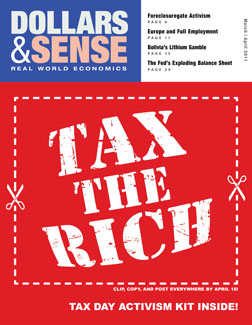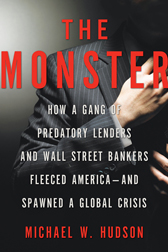This article is from Dollars & Sense: Real World Economics, available at http://www.dollarsandsense.org

This article is from the March/April 2011 issue of Dollars & Sense magazine.
Subscribe Now
at a 30% discount.

Inside the Subrime Monster
A review of The Monster: How a Gang of Predatory Lenders and Wall Street Bankers Fleeced America—and Spawned a Global Crisis by Michael W. Hudson. (New York: Times Books, 2010.)In some of the most powerful scenes in Maxed Out, the still-valuable 2007 documentary on consumer debt and predatory lending in America, the camera follows investigative reporter Michael Hudson as he visits people who had been deceived into signing onto exploitative mortgage loans that they had no chance of repaying.
In The Monster, Hudson’s highly readable new book, victims are again present, with many compelling vignettes of people who were deceived or pressured (or both) into signing up for harmful high-cost loans. But his main focus this time is on the lenders. The heart of his book is based on interviews with scores of former employees, most of whom left the industry in disgust over the ways that they were forced to take advantage of people if they wanted to keep their jobs.
Hudson (not to be confused with the economist of the same name who also writes about finance) tells the story chronologically, starting with the emergence of subprime mortgage lending in Southern California in the 1980’s. Roland Arnall was there at the beginning, at the helm of a small federal savings bank, and Hudson’s main narrative traces how Arnall’s lending operations grew into the nation’s biggest subprime lending empire. At their peak in 2004, Ameriquest and its affiliates generated $83 billion in subprime loans—and $1.3 billion in profits. The bulk of the profits flowed through to Arnall, elevating him to #73 on the Forbes Four Hundred list of the richest Americans. He took the money and ran, becoming U.S. Ambassador to the Netherlands in early 2006. Ameriquest went out of business the following year.
Arnall’s obsession with growth led to an internal culture at Ameriquest that demanded ever-higher loan volumes at all costs. That culture was captured in a memo from one manager to his sales staff: “We are all here to make as much fucking money as possible. Bottom line. Nothing else matters.” Those who could meet the ever-increasing sales targets were rewarded with money, luxury vacations, cars, and more. Those who couldn’t were fired. And the only way to meet those targets—given the high-cost nature of the loans that they were pushing—was by a combination of deception, psychological manipulation, and fraud. “Bait-and-switch” tactics were routine. Managers monitored sales pitches and berated employees who let potential borrowers escape. Offices had staffers who specialized in forging documents. Those charged with overseeing quality control and preventing fraud soon learned that the only way to hold their jobs was to just say yes. Hudson provides chapter and verse on all this and more in compelling detail.
Still, the explosive growth of subprime lenders like Ameriquest was only possible because of the big Wall Street firms that purchased their loans and packaged them into securities sold to investors. Wall Street’s quest for the generous fees gained in this process led them to be no more interested in borrowers” ability to repay their loans than were the lenders. So Hudson’s second focus is on Lehman Brothers, the biggest Wall Street backer of subprime lenders, and the picture there was no prettier than it was at Ameriquest. A Lehman executive who visited the now-infamous First American Mortgage Company (FAMCO) in the 1990s reported back that “there is something really unethical about the type of business in which FAMCO is engaged. ... [I]t is a requirement to leave your ethics at the door.” Nevertheless, Lehman eagerly sought to finance the company’s operations and buy its loans.
The number of staffers quoted and their consistent testimony as to the pervasiveness of the practices that they describe leave no doubt that predation was standard operating procedure, rather than the work of the few “rogue operators” or “bad apples” so dear to the hearts of industry apologists. (For those who want more specifics, the book’s narrative is followed by 40 pages of detailed notes, with copious references to court records, legal documents, and the business press.)
As conservatives try to rewrite recent history to justify their pro-corporate policies, Hudson’s persuasive account of how the subprime mortgage industry really worked is highly valuable. He offers no policy recommendations. But The Monster provides powerful support for those who understand the need to make the new Consumer Financial Protection Bureau into a powerful enforcer of fair and honest lending practices.
Did you find this article useful? Please consider supporting our work by donating or subscribing.
